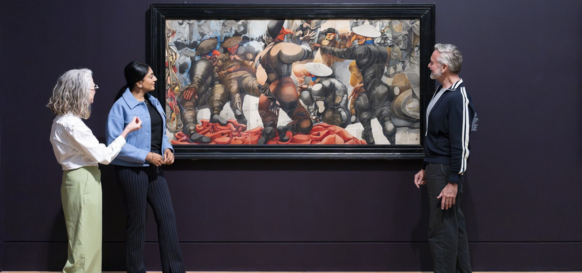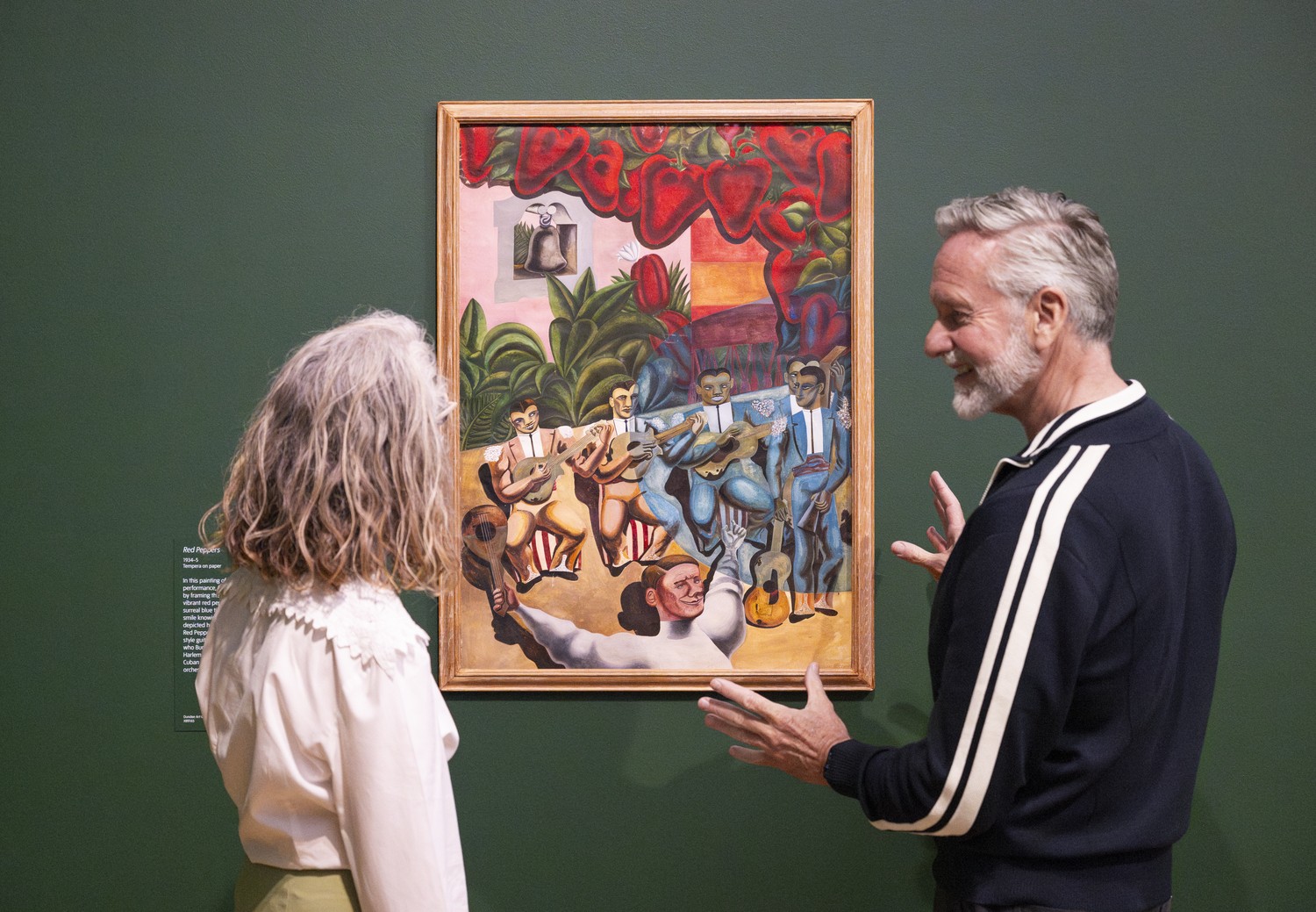Edward Burra runs in parallel with an exhibition of works by Ithell Colquhoun, offering visitors the chance to see two influential British artists with one ticket.

Edward Burra
One of the most distinctive British artists of the 20th century, the enigmatic painter Edward Burra (1905 – 1976) is best-known for his vivid and surreal scenes of cafés, clubs and cabarets. Imbued with a satirical humour, his unique works captured a rapidly changing society, sharing the experiences of those on the margins and offering a window into their world. Tate Britain presents the artist’s first retrospective in over a decade and the first in London in 40 years. From his immersion in cultural life during the Roaring Twenties, to his personal experience of major conflicts, the exhibition presents an in-depth view of Burra’s radical career across more than 80 paintings and previously unseen material from Tate’s archive.
Organised chronologically, the exhibition covers Burra’s 50-year practice, from early works painted soon after graduating from the Royal College of Art to his stage and costume designs and less exhibited later landscapes. Possessing a keenly observant eye, Burra is noted for his unusual compositions, crafted with a distinct visual language that set him apart from his contemporaries. A master of watercolour, he deployed the traditional medium in a bold manner, using bright layers of wash to create graphic, and sometimes garish works, on a large-scale. He found solace in his work, saying that ‘painting of course is a sort of drug’, and composed works on a horizontal surface to also help relieve his rheumatoid arthritis. Depicting everyday life from the perspective of an observer, the exhibition explores how he combined first-hand experiences and memories with a rich tapestry of visual references absorbed from newspapers, literature, art history, music and cinema.
Although Burra lived in East Sussex for most of his life, Tate Britain explores how his travels impacted his artmaking. Beginning with visits to Paris and the South of France in the 1920s, Burra encountered both cosmopolitan culture and those who lived on societal edges, and sympathetically included them in his compositions; queer people, sex workers, wanderers and underworld figures, inspiring notable works such as Three Sailors at the Bar 1930. Compelled by his love of music – which plays in the exhibition – he travelled to America, visiting Boston and Harlem, New York, in the early 1930s. There he immersed himself in the vibrant nightlife, enjoying the experience of crowded jazz clubs during the Harlem Renaissance. Burra translated the energy and enthusiasm he witnessed into works like Red Peppers 1934-35, capturing the multi-cultural modern metropolis, while paintings such as Dancing Skeletons 1934 explored the artist’s growing interest in Mexican culture and the macabre.
The exhibition looks at Burra’s personal experience of conflicts in Europe, which marked a turning point in his work. Fleeing his beloved Spain at the outbreak of the Spanish Civil War in 1936, he followed the conflict from England, collecting newspaper cuttings, which feature in the exhibition. Grappling with these horrors, his paintings became social commentaries on the wars. The tone of his scenes no longer retained the humour of his earlier works but became more serious and uncompromising, showing devilish figures committing violent acts, such as in War in the Sun 1938. Conflict followed Burra to England, as the outbreak of the Second World War saw England’s South Coast heavily bombed. Burra witnessed the presence of Allied troops, imagined as monstrous mask wearing figures in Soldiers at Rye 1941. Several macabre paintings such as Hostesses 1932 were included in major Surrealism exhibitions, although Burra rejected formal affiliations with artistic groups.
His outlook was radically altered by war, yet Burra’s stage and costume designs remained fun and sardonic throughout his career. The exhibition explores Burra’s lifelong affinity with ballet, opera and theatre through the designs he produced for choreographers Frederick Ashton and Ninette de Valois and productions for the Royal Opera House and Sadler’s Wells. These designs will highlight his eye for dramatic scenes drawn from memories of his hedonistic travels.
The final section of the exhibition focuses on Burra’s post-war life. Due to his declining health, his travel was limited to driving tours of Britain and Ireland, but he explored rural locations including Cornwall and the Lake District in search of sublime natural beauty. No longer interested in capturing real people in busy metropolises, Burra turned to otherworldly landscape paintings, suffused with environmental anxiety caused by the post-war industrial revolution. Mine shafts litter mountains and petrol stations occupy the countryside in Cornish Clay Mines 1970, in direct contrast to the carefree world Burra had once known and painted.

Ithell Colquhoun
One of the most radical artists of her generation, Ithell Colquhoun (1906-1988) was an important, but often overlooked figure in British surrealism. At Tate Britain following a run at Tate St Ives, this landmark exhibition is the largest of Colquhoun’s work ever staged, featuring over 130 paintings and drawings; many of which have never been publicly exhibited. The exhibition draws on Tate’s significant archive of the artist’s work, tracing the evolution of Colquhoun’s work from her early narrative paintings and engagement with the surrealist movement, to her fascination with the intertwining realms of art, sexual identity, ecology, magic and mysticism.
Following a loosely chronological path, the exhibition maps the influence of esoteric and surrealist concepts on the artist’s developing practice from the mid-1920s to the 1970s. Early paintings from her time at the Slade School of Fine Art will be presented, including Judith Showing the Head of Holofernes 1929, in which Colquhoun combines biblical subjects with fantastic architectural settings, already demonstrating her mystical interests.
The exhibition explores Colquhoun’s visual and conceptual engagement with surrealism in the 1930s and 40s. Botanical works such as Water-Flower 1938 show her evolving interest in a spiritual natural world. Colquhoun also became increasingly focused on representations of the human body through the surrealist ‘double image’ during this period, exemplified in Scylla (méditerranée) 1938, one of her most celebrated works, which merges the female form with the natural landscape. The exhibition offers the first chance to see Colquhoun’s storyboard for an unmade surrealist film titled Bonsoir 1939 in its entirety.
Tate Britain’s exhibition explores how Colquhoun engaged with the London art world through her exhibitions at the Mayor Gallery in 1939 and 1947 and offer an insight into Colquhoun’s contributions to surrealist concepts such as automatism. A turning point in her practice came in 1939 when she met Gordon Onslow Ford and Roberto Matta, who were using surrealist automatist techniques to create imagery through chance rather than conscious control. Their development of earlier surrealist ideas of automatism was intended to mine both the human psyche and other metaphysical realms. The exhibition explores how this approach became central to the evolution of Colquhoun’s intertwining artistic and occultist practice during the early 1940s when she moved away from traditional painting techniques. Her influential essay The Mantic Stain,1949 explored the spiritual possibilities of automatism, and the exhibition presents a group of paintings made using the decalcomania technique, involving the pressing together of two surfaces covered with paint to create a mirror image produced without the intentional use of the artist’s hand. Works such as Attributes of the Moon 1947 and Gorgon 1946 will show her preoccupation with channelling the spirit world. These works are shown alongside Colquhoun’s automatic experiments to demonstrate her process.
Colquhoun’s immersion in occultism developed increasingly into the 1940s, embracing ancient philosophical principles including alchemy, animism and mysticism, coupled with her own ideas about gender fluidity and interest in harnessing a divine feminine power. Her works in this period were full of magical symbolism, flowing energy channels and portals to extra dimensions Groups of works, such as a series entitled The Diagrams of Love 1940-2 reflect kabbalistic, tantric and alchemical ideas, portraying the merging of male and female forms to create an androgynous whole.
Colquhoun’s understanding of the world as a connected spiritual cosmos brought her to Cornwall from the early 1940s, where she was inspired by the region’s ancient landscape, Celtic mythologies, and neolithic monuments. Spending time between London and Cornwall, she acquired a studio in Lamorna on the Penwith peninsula in 1949 before settling in the nearby village of Paul. She published extensively: essays, surrealist novels and atmospheric travelogues including The Living Stones: Cornwall in 1957. Colquhoun’s fascination with the psychic histories of Celtic lands is evident in visionary works of sacred sites and standing stones in Cornwall and Brittany such as Dance of the Nine Opals 1942 and La Cathédrale Engloutie 1940, brought together in the exhibition for the first time.
The exhibition culminates with a section showcasing Colquhoun’s enamel drip techniques which the artist created during the final years of her life. This includes designs for a set of ‘Taro’ cards, an innovative series often considered the finest synthesis of Colquhoun’s art and magical practice, in which she departed from figuration altogether.
The Exhibitions run from the 13th of June until the 19th October
For more information and to book tickets please visit: Edward Burra – Ithell Colquhoun | Tate Britain

